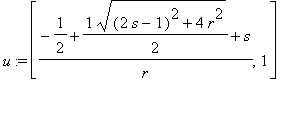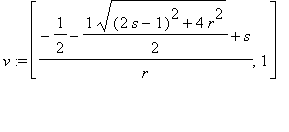Locus Problem.
Let ABC be a triangle constrained to move in the plane so that its vertices A and B always lie on a pair
![]() and
and
![]() of intersecting lines so that if A is on one line then B is on the other. Show that the locus of the point C is an ellipse.
of intersecting lines so that if A is on one line then B is on the other. Show that the locus of the point C is an ellipse.
A Solution.
Without loss of generality, assume that the lines are the x and y axes, and that the length of side AB is 1. Parameterize the point A as [t,0], where t ranges between -1 and 1. The point B takes two positions
![[0, sqrt(1-t^2)]](images/locus3.gif) and
and
![[0, -sqrt(1-t^2)]](images/locus4.gif) . Now the point C = [x,y] can be written as
. Now the point C = [x,y] can be written as
C = s*A + (1-s)*B + r*perp(A-B),
where s and r are fixed numbers, and perp(A-B) is the vector A-B rotated 90 degrees counterclockwise (so if B =
![[0, sqrt(1-t^2)]](images/locus5.gif) then perp(A-B) =
then perp(A-B) =
![[sqrt(1-t^2), t]](images/locus6.gif) and if B =
and if B =
![[0, -sqrt(1-t^2)]](images/locus7.gif) then perp(A-B) =
then perp(A-B) =
![[-sqrt(1-t^2), t]](images/locus8.gif) ).
).
To show that C traces out an ellipse, write parametric equations for C and eliminate the parameter:

Case 1
.

To eliminate the parameter, solve the equations for t and
 , and substitute those values into the equation
, and substitute those values into the equation
 .
.

Making the substitution, we get

This quadratic equation in x and y graphs an ellipse (since it is not a hyperbola or parabola). Below is a typical locus where r = 2 and s = 1. Note that the foci have been inserted. See below for the computation.
![[Maple Plot]](images/locus15.gif)
Here is a locus where the the "triangle" ABC is a segement: r = 0, s = 1.5
![[Maple Plot]](images/locus16.gif)
To compute the foci
of the ellipse, note that the ellipse
 is the image of the circle
is the image of the circle
 under the linear transformation defined by the matrix
under the linear transformation defined by the matrix
![A := matrix([[-1+s, r], [r, -s]])](images/locus19.gif)
The eigenvectors and eigenvalues of A are
 ,
,
 , and
, and
 ,
,
 . Since A is symmetric, we know the eigenvectors are perdicular and form the principal axes of the ellipse. The eigenvalues (in absolute value) are the major semi-axis
. Since A is symmetric, we know the eigenvectors are perdicular and form the principal axes of the ellipse. The eigenvalues (in absolute value) are the major semi-axis
 in the director of v and minor semi-axis
in the director of v and minor semi-axis
 in the direction of u. So the foci are
in the direction of u. So the foci are
![F[1] = sqrt(M^2-m^2)](images/locus26.gif)
![]() and
and
![F[2] = -sqrt(M^2-m^2)](images/locus28.gif)
![]() .
.
Note that the ellipse is a circle exactly when
 , that is, when s = 1/2 and r = 0; geometrically, this says the only time the trace of C is a circle is when C is the midpoint of the segment AB. Here is the locus at that point.
, that is, when s = 1/2 and r = 0; geometrically, this says the only time the trace of C is a circle is when C is the midpoint of the segment AB. Here is the locus at that point.
![[Maple Plot]](images/locus31.gif)
Case 2.

At time t =1, the vertex C is at [s,r] and the segment AB is the unit segment [[0,0],[1,0]]. Note the point [s,r] is on the circle of radius 1/2 centered at [1/2,0] and so the triangle ABC is a right triangle with the vertex C opposite the hypotenuse. We can eliminate here the parameter t by multiplying x by r and y by s and subtracting, to get 0. So the vertex C traces out a segment on the line y =
![]() x. With a little more work, one could show this segment to be a diameter of the unit circle.
x. With a little more work, one could show this segment to be a diameter of the unit circle.
Here is an animation showing the trace of C in magenta for all the exceptional values for r and s.
![[Maple Plot]](images/locus34.gif)
Maple computations